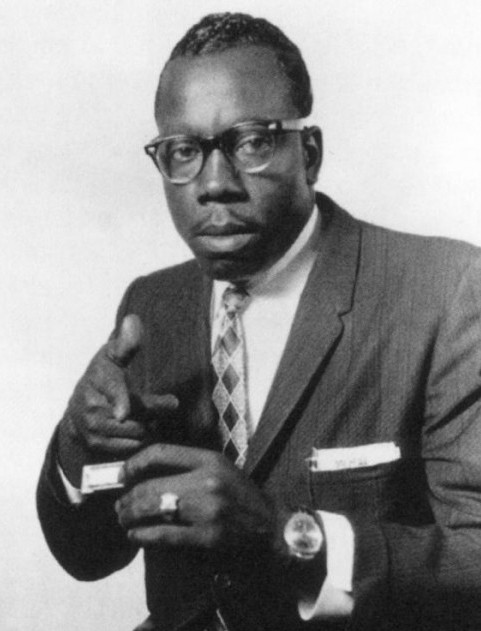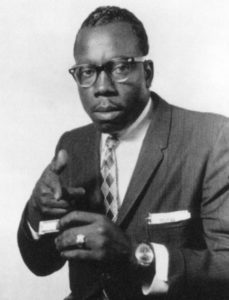Slim Harpo
Baton Rouge guitarist, singer, and harmonica player James "Slim Harpo" Moore, one of the last traditional blues musicians to achieve pop success, was an important influence on many 1960s rock bands.

Image Source Unknown.
Slim Harpo.
Baton Rouge guitarist, singer, and harmonica player James “Slim Harpo” Moore, one of the last traditional blues musicians to achieve pop success, was an important influence on many 1960s rock bands. He made his early recordings, often dubbed “swamp blues,” for the Excello Records label with famed producer Jay D. Miller. Of the swamp blues musicians Miller recorded in his Crowley studio, Moore was the most successful. His warm, laconic vocals and laid-back yet insistent rhythms characterized hit songs ranging from the blues of “I’m a King Bee” to the ballad “Rainin’ in My Heart” to the early funk of “Baby, Scratch My Back” to “Bobby Sox Baby,” Moore’s attempt to cash in on the rock and roll craze.
Early Life
Born James Isaac Moore on January 11, 1924, in Lobdell, Slim Harpo grew up in nearby Port Allen, where he taught himself to play guitar and harmonica. After his parents passed away, he dropped out of school after the tenth grade to help provide for his brother and three sisters. After a stint as a dockworker in New Orleans, Moore later returned to Baton Rouge to work as a building contractor.
After marrying in 1948, Moore pursued music as a full-time career, playing in clubs, juke joints, and parties throughout south central Louisiana under the stage name “Harmonica Slim.” He also began a lifelong partnership with fellow bluesman Otis “Lightnin’ Slim” Hicks after seeing Hicks perform at a local juke joint in the mid-1950s. Moore recorded with and accompanied Hicks during several live performances, and Hicks later married one of Moore’s sisters.
Career Development
Moore’s first recorded performance was as a backing musician on Lightnin’ Slim’s “Lightnin’ Blues,” produced at Excello studio in Crowley in 1955. He continued to play with Hicks until 1957, when Moore recorded his first single, “Got Love if You Want It.” (It was the B-side on an Excello record, “I’m a King Bee,” that became a hit.) Excello’s producer, Jay Miller, pointed out that there was already a blues performer calling himself “Harmonica Slim” on the West Coast and encouraged Moore to change his stage name. Moore’s wife, Lovelle, who later co-wrote many of his best-known songs, reversed his name and added an “O” to the slang term for harmonica to create “Slim Harpo.”
Though he liked Moore’s harmonica playing, Miller was not impressed with his singing and urged him to adopt a more nasal tone—a style popular at the time thanks to country singer Hank Williams. In addition to this country cadence, many of Moore’s songs showcased Miller’s unusual production techniques, which often featured the heavy use of echo and percussion (made with woodblocks and/or maracas) to create a distinctive sound. Other musicians who recorded for Miller’s Excello label, such as Leslie “Lazy Lester” Johnson and Gabriel “Guitar Gable” Perrodin, sometimes played on Moore’s recordings.
Moore’s next hit was the ballad “Rainin’ in My Heart,” which reached #17 on the Billboard rhythm and blues (R&B) charts and #34 on the pop charts in 1961. It has become a standard among country and Cajun musicians as well as blues singers. In 1961 Moore soon believed that he was not receiving the royalties he was due and left Excello for the Imperial label. He returned to Excello in 1963, though it was 1966 before he enjoyed his next hit, the proto-funk number “Baby, Scratch My Back,” which hit #1 on the Billboard R&B charts and #16 on pop charts in 1966. Moore described the tune as his attempt at rock ‘n’ roll. Later, he had two more minor R&B hits with “Tip on In, Part 1” (#37 R&B in 1967) and “Te-Ni-Nee-Ni-Nu” (#36 R&B in 1968).
By the late 1960s, Slim Harpo was attracting notice from the young, white “hippie” audience, and over the next few years he began playing well-known concert venues such as Whiskey-A-Go-Go in Los Angeles and Fillmore East and Electric Circus in New York City instead of his typical Southern “chitlin circuit” clubs. Yet Moore—by all accounts, an easygoing, affable man who did not let stardom go to his head—maintained his own trucking business during the 1960s in addition to pursuing musical endeavors.
While preparing for his first European tour, as well as a recording session in England, the reportedly clean-living Moore (who had rarely been sick), was felled by an unexpected heart attack, dying on January 31, 1970, at the age of forty-six. He is buried in Mulatto Bend Cemetery in Port Allen. Moore was inducted into the Blues Foundation Hall of Fame in 1985, and his song, “I’m a King Bee,” was named to the Grammy Hall of Fame in 2008.
Cultural Significance
Something about Moore’s songs appealed to British bands in the 1960s. The Rolling Stones covered “I’m a King Bee” on their first album, while other songs found their way into the repertoires of The Yardbirds, The Kinks, The Pretty Things, Pink Floyd, and Them. Some have speculated that the simple and relaxed feel of Moore’s songs made them easy for young white blues and rock ‘n’ roll bands to play. Texas band ZZ Top adapted Moore’s “Shake Your Hips” riff for their early hit “La Grange,” while The Rolling Stones covered the same song, retitled “Hip Shake,” on their Exile on Main Street album. Hank Williams, Jr., had a hit with his 1971 version of “Rainin’ in My Heart,” and Moore’s songs have also been recorded by Dave Edmunds, The Fabulous Thunderbirds, and Alex Chilton. The Moody Blues even named themselves after a Slim Harpo instrumental.
Though Moore’s songs lend themselves well to variation, the languid soulfulness and catchy production of his original Excello recordings has never been successfully duplicated. As Mick Jagger once asked rhetorically in a Rolling Stone interview, “What’s the point in listening to us doing ‘I’m a King Bee’ when you can listen to Slim Harpo doing it?”
